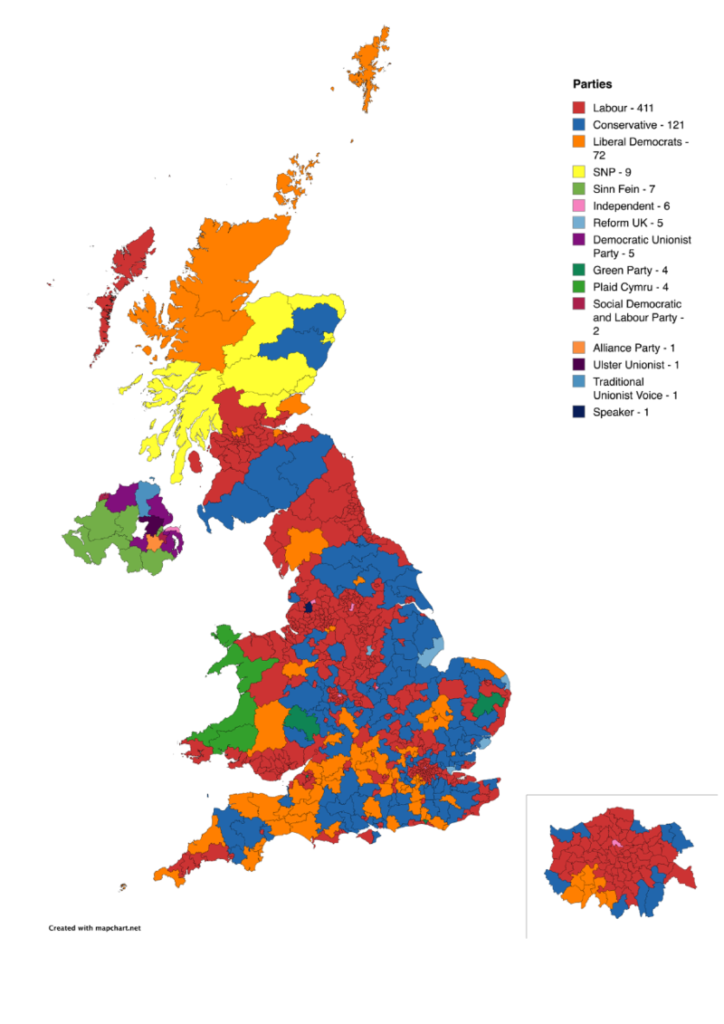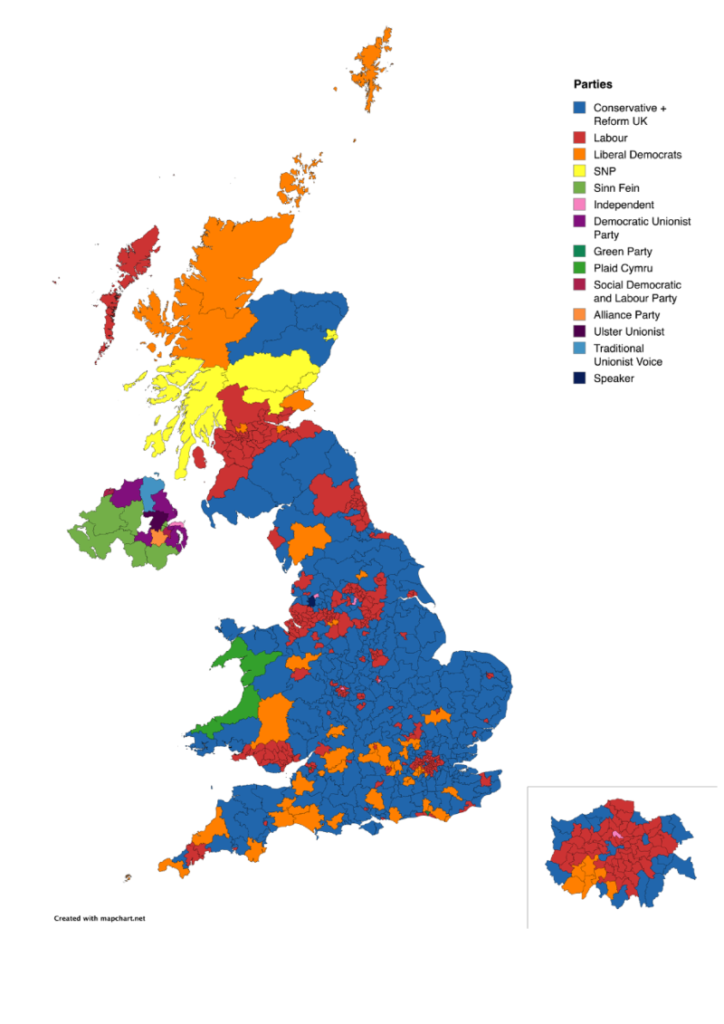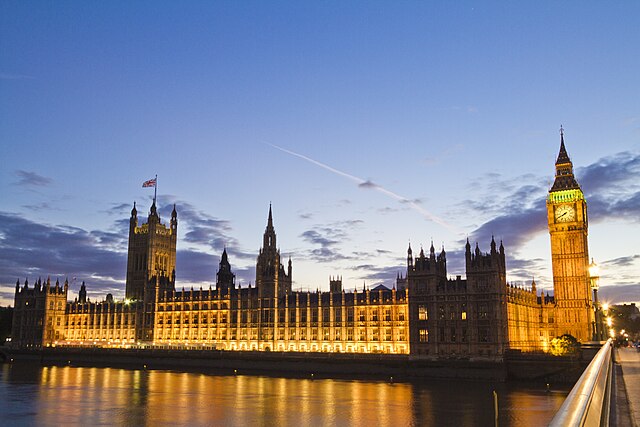Written by Roman de Prez,
With the Labour Party winning its second-largest majority in its 124-year history, you could be forgiven for thinking that left-wing ideas were flourishing amongst the country’s electorate. When taking a deeper dive into electoral statistics though, you might be surprised to see how healthy the country’s right-wing voting bloc is.
The UK’s historically socialist Labour Party has presented itself as the exception in a Europe where right-wing parties are in the ascendancy. Labour’s stomping parliamentary majority in July might seem like a beacon of leftist hope. However, a closer examination reveals that this triumph was less about a resurgence of left-wing ideology among British voters and more about the fragmented and disorganised state of the right-wing opposition.
Labour’s first few months in government have been anything but smooth. Since their election in July, the party has grappled with a gift-giving scandal, a slump in business confidence, protests from farmers over the budget, and a petition calling for a change in government that garnered over two and a half million signatures. To compound Labour woes, only last week a Sky News/YouGov national poll showed Labour trailing the insurgent, right-wing Reform UK, a party this article will soon return to. To Labour loyalists, these developments must feel worlds apart from the halcyon days of their 1997 victory, where there was a notable air of optimism and hope amidst the national psyche.
Given Labour’s stomping electoral success, one might wonder where all this dissatisfaction within the country has emerged from. Himself being no stranger to a football analogy, Prime Minister Keir Starmer must feel like a crowd who were jubilantly singing his praises before kick-off have all of a sudden lost their voice. Taking a closer look into the voter breakdown, though, it appears that the relative lack of noise from the opposition stands came down to the fact that a newer rival team had poached a great deal of their support.
I’m referring, of course, to the aforementioned Reform UK, the party colloquially described by their leader, veteran right-wing Eurosceptic Nigel Farage, as the ‘new kids on the block‘ of British Politics. Farage previously led the party under its former name, ‘The Brexit Party,’ into the 2019 general election where, unlike in the most recent election, Farage strategically chose not to contest Tory seats, knowing that splitting the right-wing vote would likely hand victories to parties to his left. This decision played a pivotal role in securing the Conservatives’ largest majority in 30 years while contributing to Labour’s lowest number of seats since 1935.
This raises an important question: what would the outcome of the most recent election have been if the right-wing vote hadn’t been split? To explore this, I analysed the results in every UK constituency, combining the Conservative and Reform UK votes to determine whether this unified right-wing bloc would have surpassed Labour’s totals.
Actual Seat Numbers:
| PARTY | SEATS |
| LABOUR | 411 |
| CONSERVATIVE | 121 |
| LIBERAL DEMOCRATS | 72 |
| SCOTTISH NATIONAL PARTY | 9 |
| SINN FÉIN | 7 |
| INDEPENDENT | 6 |
| REFORM UK | 5 |
| DEMOCRATIC UNIONIST PARTY | 5 |
| GREEN PARTY | 4 |
| PLAID CYMRU | 4 |
| SOCIAL DEMOCRATIC AND LABOUR PARTY | 2 |
| ALLIANCE PARTY OF NORTHERN IRELAND | 1 |
| ULSTER UNIONIST PARTY | 1 |
| TRADITIONAL UNIONIST VOICE | 1 |
| SPEAKER | 1 |
Hypothetical Seat Numbers:
| PARTY | SEATS | CHANGE |
| CONSERVATIVE + REFORM UK | 299 | +178 |
| LABOUR | 267 | -144 |
| LIBERAL DEMOCRATS | 49 | -23 |
| SCOTTISH NATIONAL PARTY | 7 | -2 |
| SINN FÉIN | 7 | 0 |
| INDEPENDENT | 6 | 0 |
| DEMOCRATIC UNIONIST PARTY | 5 | 0 |
| GREEN PARTY | 2 | -2 |
| PLAID CYMRU | 2 | -2 |
| SOCIAL DEMOCRATIC AND LABOUR PARTY | 2 | 0 |
| ALLIANCE PARTY OF NORTHERN IRELAND | 1 | 0 |
| ULSTER UNIONIST PARTY | 1 | 0 |
| TRADITIONAL UNIONIST VOICE | 1 | 0 |
| SPEAKER | 1 | 0 |
A united right-wing bloc would have secured a majority.
Hypothetical seat calculations show that a united right-wing bloc would have secured a majority, highlighting the continued strength of conservative ideologies in the UK despite Labour’s win.
Actual Seat Map:

hypothetical Seat Map:

The results reveal a significant shift in the UK’s parliamentary makeup. The combined right-wing bloc of the Conservative Party and Reform UK would secure a majority with 299 seats, while Labour would come in second with 267 seats. This suggests that a substantial portion of the electorate still favours conservative ideologies, though the vote is currently split between two major right-wing parties.
I should add the caveat that these results are purely hypothetical. They rely on the assumption that all Reform UK voters would have switched to the Conservatives were Reform not to have stood in the election. However, this is impossible to confirm Some Reform UK voters might have chosen to back other parties, while others may have opted to abstain from voting altogether.
With this caveat in mind, it’s also important to note that these figures do not account for another potential voting split in right-wing constituencies: the Liberal Democrats. In this election, the Lib Dems gained 64 seats, with 60 of those coming from the Conservatives suggesting the Lib Dems largely attracted votes from the Conservative side.
While Labour’s impressive parliamentary victory in July should not be dismissed, it is crucial not to overstate its significance, especially in the broader European context. For those who view the UK as a bastion against the rise of the right, the results might offer a false sense of security. The success Labour achieved largely stemmed from the disarray within the right-wing vote rather than a clear, enduring shift in public sentiment toward the party.
you might be interested in…
The Rise of the Radical Right is a Threat to (Liberal) Democracy as we Know it
Press Contact
Charles Cooper, Public Relations Lead of the International Association for Democracy (IAD)Mail: press@iad.ngo
Tel: +44 7494 161888
Sources:
https://www.bbc.co.uk/news/election/2024/uk/constituencies
https://commonslibrary.parliament.uk/research-briefings/cbp-10009/
https://www.mapchart.net/uk-election.html
https://fullfact.org/election-2024/general-election-result-numbers/
https://www.cfr.org/expert-brief/how-far-right-election-gains-are-changing-europe
https://www.politico.eu/article/eu-european-election-results-2024-swings-right-france
https://www.independent.co.uk/news/uk/nigel-farage-colum-eastwood-ed-davey-john-bercow-rishi-sunak-b2576739.html
https://commonslibrary.parliament.uk/general-election-2019-the-results-so-far
https://www.bbc.co.uk/news/election-2019-50377396
https://www.bbc.co.uk/news/articles/cdd4z9vzdnno
https://www.ft.com/content/3565de44-4d91-41aa-b291-1b9bf094cd14


